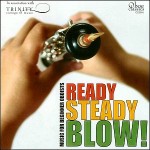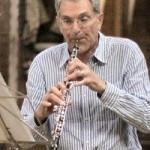by guest blogger, Jeremy Polmear, Oboe Classics
The pieces in this playlist range in technical difficulty from grade 2 to way beyond grade 8. Many of them appear in the exam lists of the ABRSM and others, but my main purpose is to show that whatever level of oboist you are, there is good music out there for you to play.
 The first nine tracks come from the Oboe Classics CD ‘Ready, Steady, Blow’, which has interesting pieces even at the pre-grade 1 level. However the tracks that are up on Spotify start at the Grade 2 level. It was recorded back in 2004 by four Graduate students at Trinity Laban college of music and dance, and these photos are taken from those recording sessions.
The first nine tracks come from the Oboe Classics CD ‘Ready, Steady, Blow’, which has interesting pieces even at the pre-grade 1 level. However the tracks that are up on Spotify start at the Grade 2 level. It was recorded back in 2004 by four Graduate students at Trinity Laban college of music and dance, and these photos are taken from those recording sessions.
1. Pastime with good company (grade 2) is attributed to Henry VIII (1491-1547), and it’s a nice idea – he certainly liked music, as well as having all those wives. Here, Jenni Britton is accompanied by Marcus Andrews (piano) and Amy Kelly (tabor).
2. Dragonfly (grade 2). Pam Wedgewood has written a lot of good music for beginners, and in this one Uchenna Ngwe floats the oboe line above a lilting piano accompaniment from Philip Cornwell.
3. Purcell Air (grade 3). Some years ago I found myself playing the recorder at a performing arts school in Tamil Nadu, south India, and trying to remember the fingerings. I included this piece, and afterwards one of the school administrators (who knew nothing of western classical music) said to me “of all the music you played that piece, by Purcell, was something special”. Exactly; Henry Purcell (1659-95) can conjure up a mood using the simplest of melodies. Here, Alex Birchell is accompanied by Marcus Andrews.
4. Somewhere over the Rainbow (grade 3). Julia White, accompanied by Marcus Andrews, plays this tune from ‘The Wizard of Oz’ with a beautiful simplicity, bringing out the wistful mood.
5. I got Rhythm (grade 3). This is a simple but effective arrangement of the George Gershwin (1898-1937) tune by Jim Parker, himself an oboist. Uchenna and Philip are the players, and make the most of the bouncy feel, and the gaps in the music.
6. A song of the hills (grade 3). This is an original piece – not an arrangement – by Michael Head (1900-76), and is in the style known as ‘English Pastoral’ – gentle and wistful. Julia and Marcus are playing, and this is very much a duet, not oboe plus piano. Julia says she loves English music, and you can hear it in this performance.
7. Musette (grade 3). The picture shows an 18th-century player of the Musette, an instrument like the bagpipes but quieter. Nicolas Chédeville (1705-82), the composer of this beautiful, gentle piece, played the musette and also the oboe. In this version Jenni plays oboe, Marcus piano, and I play the drone on the cor anglais.
8. Sunday Morning (grade 3). An original piece by Jim Parker (who also arranged ‘I got rhythm’), played by Uchenna and Philip. A lovely, simple piano riff provides a cushion for the oboe to glide gently through this simple, effective melody.
9. Hedwig’s theme (grade 4). Part of John Williams’ music for the Harry Potter films, this is, as one teacher put it, by far the best way to learn the bottom two notes of the oboe. Alex and Marcus conjure up a stylish performance.
10. The Swan (grade 4). We now move from four talented post-graduate students to Léon Goossens (1897-1988), possibly the most famous oboist ever. Here he is playing The Swan, from the Carnival of the Animals by Camille Saint-Saëns (1835-1921), a piece originally written for the cello.
11. Jesu, Joy of Man’s Desiring (grade 5). Here is Goossens again, playing a wedding favourite by J S Bach (1685-1750).
12. Albinoni, Concerto in C Op 9 no 12, first movement (grade 6). Tomaso Albinoni (1671-1751) brings an Italian lighness and playfullness to this movement, fully brought out by one of the best known players of the instrument, the Swiss oboist and composer Heinz Holliger.
13. Gabriel’s Oboe (grade 6). In the movie The Mission Jeremy Irons, playing a Jesuit priest, arrives in 1750s South America to convert the Guarani people. In an effort to make friends he gets out his oboe and reed (which he’s kept ready in the jungle) and plays this tune. It works, though the chief of the tribe later snaps the oboe across his knee. Being a baroque oboe, it snaps quite easily. In this version of Ennio Morricone’s tune I use a modern oboe, with Diana Ambache on the piano, unlike the jungle version which of course contains its own symphony orchestra.
14. J S Bach Sonata in G minor, BWV 1020, third movement (grade 7). This is sometimes called the ‘little’ G minor because there is a longer one; this one is sometimes played on the flute, and some people think is not even by Bach. It certainly feels like Bach, and all three movements are lovely. I am playing it here again with Diana, and in this movement the trick is to keep things lively, perky and interesting.
15. Walmisley oboe Sonatina no 1, second movement (grade 7). Thomas Attwood Walmisley (1814-56) is mostly remembered for his church music, but here is a lovely example of 19th Century Salon music, designed for performance in a beautiful drawing room. Oboist Eric Speller brings out the romantic side of the music without ever letting it get too grand.
16. Haydn oboe concerto, third movement (grade 8). This is another work that some say may not actually be by Joseph Haydn (1732-1809). No matter, it’s a delightful movement, and like so much of Haydn’s music, refuses to take itself too seriously. Paul Goodwin plays it on the classical oboe, and at a lower pitch than the current one. Another difference is that the little twiddles may not be the same as in your edition… and when you perform it, you can make up your own.
17. Poulenc, Oboe Sonata – first movement (grade 8). If the Haydn piece keeps to one mood throughout the movement, this piece is quite the opposite, veering around from intense sadness to anger to desolation. Nicholas Daniel, the UK’s best-known oboist, brings out all these moods to perfection.
18. Pasculli, Le Api (The Bees) (grade xxx). Here is a piece designed to make an audience gasp! Antonio Pasculli (1842-1924) was a virtuoso player who wrote pieces for himself to perform. It’s not hard to see that his fingerwork must have been remarkable, as well as his mastery of circular breathing. Perhaps more surprising is that the music manages to remain good-humoured throughout, particularly in the capable hands of Christopher Redgate. (This track can also be seen in a visual version at https://www.youtube.com/watch?v=Oxu7L3yqdn8.)
19. John Casken, Amethyst Deceiver (2009) (grade xxx). This piece is inspired by the idea of a mysterious woodland locale in which strange things come to life. (‘Amethyst decievers’ are tiny purple mushrooms that look like the poisonous Lilac Fibrecap, but are in fact edible when cooked.) It is indicated to be played ‘freely, and with an air of mischief’, which it certainly is in the expert hands of the author of this website, James Turnbull. Notice how contemporary techniques – quarter tones, chords – are used naturally, to add mystery and magic to the composition.
——————————
ABOUT JEREMY POLMEAR
Jeremy Polmear has made four recordings in partnership with the pianist Diana Ambache, and they have given recitals in thirty three countries as well as at London’s Wigmore Hall and Purcell Room. They have created programmes of words and music with actors such as Jenny Agutter, Billie Whitelaw and Susanna York, and have given courses for the City University Business School and London Business School, using the arts as a management training tool. As a freelance oboist, Jeremy has played with a number of the capital’s chamber and ballet orchestras, including the London Mozart Players, English National Ballet and the City of London Sinfonia. He founded the CD label Oboe Classics in 2002, and performs on five of its 29 titles.
They have created programmes of words and music with actors such as Jenny Agutter, Billie Whitelaw and Susanna York, and have given courses for the City University Business School and London Business School, using the arts as a management training tool. As a freelance oboist, Jeremy has played with a number of the capital’s chamber and ballet orchestras, including the London Mozart Players, English National Ballet and the City of London Sinfonia. He founded the CD label Oboe Classics in 2002, and performs on five of its 29 titles.
